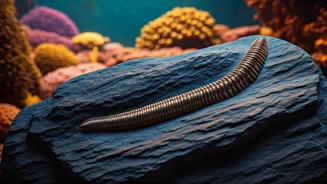Mandarin Dragonet
The Mandarin Dragonet is a true jewel of the reef, sporting an extravagant array of colors that seem almost unreal. With vibrant blues, oranges, greens,
and yellows, these fish are a feast for the eyes. They are typically found in the tropical waters of the Pacific Ocean, where they navigate the coral reefs with elegance. Their diet consists mainly of small invertebrates, and they spend their days meticulously picking through the reef. These creatures are relatively small, usually reaching only about 3 inches in length. They are also known for their intricate mating rituals, which involve a mesmerizing display of colors and synchronized movements. Because of their delicate nature and specific dietary needs, they are a challenging species to keep in aquariums. Their existence is a reminder of nature's beauty.
Royal Gramma's Splendor
The Royal Gramma presents a remarkable contrast, with its body divided into two distinct colors. The front half of the fish is a deep purple, transitioning to a bright yellow in the rear. These fish are native to the Western Atlantic Ocean, particularly the coral reefs surrounding the Caribbean. They usually inhabit crevices and caves within the reef structure, creating their territories. They are small in size, generally reaching about 4 inches. They play an essential role in the reef ecosystem by consuming small crustaceans and algae. They have a fascinating social behavior, often observed in small groups or pairs. The Royal Gramma is popular in the aquarium trade, due to its stunning appearance and relative hardiness.
Regal Angelfish's Majesty
The Regal Angelfish is a standout beauty of the ocean depths. These fish are adorned with a striking pattern of vibrant yellow and blue stripes and bands. They are typically found in the reefs of the Indo-Pacific region, where they navigate the coral gardens with grace. Their diet includes sponges, algae, and small invertebrates. They can grow up to 12 inches, making them one of the larger fish in this selection. Regal Angelfish are known for their territorial behavior, and they often form pairs or small harems. Preserving their natural habitat is essential to ensure that future generations can admire the beauty of the Regal Angelfish.
Clownfish's Iconic Charm
The Clownfish, also known as the anemonefish, is instantly recognizable due to its bright orange body and white stripes. These fish live in symbiotic relationships with sea anemones in the warm waters of the Indian and Pacific Oceans. The clownfish finds protection from predators within the stinging tentacles of the anemone, while the anemone benefits from the clownfish keeping it clean and providing it with nutrients. There are about 30 different species of clownfish, each with slight variations in color and pattern. Their size usually reaches about 4 inches. They play an important role in the health of the coral reef ecosystem, and their striking appearance has made them a popular subject in marine education and conservation efforts.
Moorish Idol's Elegance
The Moorish Idol is a distinctive fish with a flattened body, striking yellow, black, and white markings, and a prominent dorsal fin that streams behind it. They are closely related to the butterflyfish, and their presence enhances the aesthetic appeal of a coral reef. These fish inhabit the warm waters of the Indo-Pacific region, including areas around coral reefs. They can grow up to 9 inches, and they feed on sponges and small invertebrates. Their unique appearance and elegant swimming style make them a favorite subject for underwater photographers. The Moorish Idol’s survival is linked to the preservation of coral reefs.
Blue Tang's Radiance
The Blue Tang, also known as the surgeonfish, is renowned for its brilliant blue coloration and vibrant yellow markings. Found in tropical waters around the world, they are a common sight on coral reefs. These fish play an important role in reef health by consuming algae. They are equipped with a sharp spine near their tail, which they use for defense. They typically grow up to 12 inches, adding splashes of color to their habitat. The survival of the Blue Tang, like many reef species, is increasingly impacted by environmental issues such as coral bleaching and overfishing. Conservation efforts are crucial to protect their future.
Lionfish's Bold Appeal
The Lionfish is immediately recognizable for its striking appearance, featuring bold stripes and venomous spines. Native to the Indo-Pacific, these fish have become invasive in the Atlantic Ocean, where they pose a significant threat to native reef ecosystems. Their spines inject a potent venom, which they use for defense. They feed on a variety of small fish and invertebrates, and their rapid reproduction rate contributes to their invasive success. They are a threat to other local species. They can grow to be up to 18 inches long. Efforts to control lionfish populations include targeted hunting programs, which aim to reduce their numbers and protect the native marine life.











